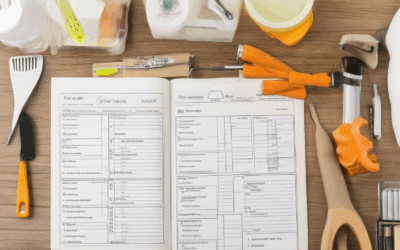Are you ready to unlock the full potential of your home? Imagine transforming your living space into something extraordinary without breaking the bank or hiring professionals. DIY house improvement isn’t just for experts—it’s a skill anyone can master. Whether you’re looking to add a personal touch to your decor, save money, or tackle those lingering projects, this guide has everything you need to get started. From budget-friendly upgrades to creative repurposing of household items, we’ll walk you through the ins and outs of making your home truly yours. With a mix of practical tips, inspiring ideas, and actionable steps, this article is your ultimate companion for turning your house into a haven you’ll love. Let’s dive in and discover how you can achieve amazing results with DIY projects that fit your style and your budget!
Key Takeaways
– Prioritize Kitchen Remodels: Start with the kitchen to manage dust and debris effectively, enhancing both functionality and aesthetics.
– Address Plumbing Issues Early: Fix leaky pipes or outdated fixtures to prevent water damage and mold growth.
– Update Electrical Systems Safely: Upgrade wiring and install new outlets before other renovations to ensure safety and avoid future hazards.
– Install Durable Flooring Materials: Replace old tiles with sturdy options like hardwood or tile for a stable and long-lasting finish.
– Refresh Interiors Post-Dust: Use high-quality paint or wallpaper to achieve a polished look once initial dust has settled.
– Enhance Energy Efficiency: Replace windows and doors to improve insulation and curb appeal.
– Plan Thoroughly: Define goals, budget, and timeline to ensure efficient project execution.
– Conduct a Property Inspection: Identify issues like roof leaks, foundation cracks, and water damage before starting renovations.
– Upgrade Fixtures and Appliances: Replace outdated items to improve safety and functionality.
– Test Electrical Systems: Ensure all outlets and wiring are safe and functional.
– Organize Temporary Living Spaces: Keep areas clutter-free and accessible during renovations.
– Ensure Structural Integrity: Perform necessary structural work to maintain the house’s stability.
– Install New Fixtures Thoughtfully: Arrange lighting and decorative elements for a cohesive aesthetic.
– Complete Final Touches: Finish with painting, flooring, and landscaping to achieve a polished look.
– Inspect Post-Renovation: Ensure everything functions smoothly and meets safety standards.
– Clear Clutter: Remove obstacles and store items safely to prevent tripping hazards.
– Obtain Necessary Permits: Secure required approvals and schedule regular inspections throughout the project.
– Consider Professional Help: Hire experts for complex tasks to ensure quality and safety.
These key takeaways encapsulate the essential strategies and actions for successful DIY home improvements, ensuring both functionality and aesthetics are met.

What is the 30 Rule in Home Renovation?
The 30% rule in home renovation is a guideline that helps homeowners manage their budgets effectively during renovations. It suggests that renovation costs should not exceed 30% of the property’s current market value. This rule helps prevent overspending and ensures that the investments made during the renovation provide a healthy return on investment.
Here’s a breakdown of how the 30% rule works:
- Assess Market Value : Begin by determining the current market value of your home. This can typically be found through a professional appraisal or online valuation tools.
- Calculate Budget : Based on the assessed market value, set your renovation budget to not exceed 30% of this value. This ensures that you stay within reasonable limits and avoid overspending.
- Prioritize Necessary Upgrades : Stick to essential upgrades that add value to your home rather than focusing on luxury features unless they are proven to increase the property’s worth significantly.
- Monitor Costs : Keep track of all expenses related to the renovation to ensure you stay within your budget. If you notice costs rising beyond the 30% threshold, reconsider your plans or seek alternatives to stay aligned with the rule.
By adhering to the 30% rule, you can make informed decisions that align with your financial goals and ensure a successful renovation project.
How Can I Upgrade My House Cheaply?
Upgrading your house doesn’t have to break the bank. With a little creativity and effort, you can make meaningful improvements that enhance both functionality and aesthetics. Here are some cost-effective ways to refresh your home:
- Paint Your Walls : A fresh coat of paint can completely transform a room. Opt for latex paint, which is durable and easy to clean. Use a primer before repainting to ensure better coverage. Check out budget-friendly options at local hardware stores.
- Update Fixtures and Hardware : Replace outdated fixtures and hardware for a modern look. Visit stores like Home Depot or Lowe’s for affordable options. Consider upgrading your kitchen faucet and door handles, and switch out LED bulbs in your bathroom for a sleeker lighting solution.
- D.I.Y. Projects : Refinish your cabinetry for a polished look without the high cost of replacement. Follow online tutorials to learn how to do it yourself. Declutter and organize your space to create a fresh atmosphere.
- Landscape Your Yard : Tackle landscaping projects to boost curb appeal. Remove dead plants, plant ground cover, and add potted plants near your entrance. Power wash your driveway and walkway for a clean look.
- Exterior Touch-Ups : Clean and repair your gutters to prevent water damage. Replace peeling shingles individually if needed, rather than the entire roof, to save costs.
- Improve Water Quality : Install a water softener to reduce hardness. Look for affordable, easy-to-install models available at most hardware stores.
- Energy-Efficient Appliances : Upgrade to newer, more efficient appliances like refrigerators and washers. Check if your current models are outdated and consider the long-term savings on utilities.
- Add Greenery Indoors : Introduce low-maintenance plants like snake plants or succulents to brighten your space and improve air quality.
- Safety Checks : Replace smoke detectors and carbon monoxide detectors if necessary. Inspect fire extinguishers and ensure they’re functioning properly.
- Garage Organization : Organize tools and storage spaces. Use bins, shelves, and wall hooks to keep everything tidy and easily accessible.
- Fix Leaky Pipes and Small Repairs : Address minor plumbing issues and replace worn-out tiles to prevent future problems. Watch tutorials for simple fixes and consult friends for advice if needed.
- Minor Repairs : Patch chipped tiles and fix broken window screens with quick solutions found online.

Renovating Your Old House on a Budget
Renovating your old house doesn’t have to break the bank. With a bit of creativity and elbow grease, you can transform your space into something beautiful and functional. Here’s how you can tackle renovations without spending a dime.
1. Start Small with Minor Fixes
- Patch Walls and Ceilings: Identify cracks or holes and fill them using spackling compound. Once dry, sand and paint to make surfaces smooth and visually appealing.
- Clean Surfaces: Use a mix of white vinegar and baking soda to clean tiles, grout, and other surfaces. This combination is effective and budget-friendly.
2. Declutter and Reorganize
- Repurpose Items: Turn old blankets into throws or use them as padding for seating areas. Old sheets can be repurposed as dust cloths or cleaning rags.
- Organize Spaces: Use jars, baskets, or shoeboxes to corral items like nails, screws, or small parts. Group similar items together to keep your space tidy.
3. Enhance Lighting
- Clean Light Fixtures: Dust off ceiling fans, chandeliers, and table lamps to let more light shine through. Replace burned-out bulbs with energy-efficient LEDs for better lighting and savings.
4. Kitchen and Bathroom Makeovers
- Reorganize the Kitchen: Clear countertops by grouping essentials into open bins or using drawer organizers. Clean under appliances and declutter drawers.
- Bathroom Refresh: Scrub tiles and grout with a mixture of water and vinegar. Check for leaky pipes or fixtures and address them if possible. Test for leaks using food coloring placed near pipes.
5. Exterior Touch-Ups
- Clean Gutters and Windows: Remove debris from gutters and clean windows to allow more light and airflow. Power wash the exterior to eliminate dirt and grime.
- Paint and Seal: Touch up peeling paint on trim and siding. Use caulk to fill small holes in siding and seal gaps to prevent drafts.
6. Furniture Fixes
- Repair Wobbly Chairs: Adjust chair legs or tighten loose screws to stabilize them. Sand and refinish wooden furniture to restore its appearance without buying new pieces.
- Add Comfort: Use old pillows or cushions to make seating areas more inviting.
7. Safety Checks
- Inspect Electrical Systems: Look for loose wires or faulty switches. Test smoke detectors and carbon monoxide alarms to ensure they’re functioning properly.
8. Introduce Plants
- Low-Maintenance Plants: Add plants like snake plants or pothos to brighten up rooms. Consider growing herbs in window boxes for fresh produce and a green touch.
9. Declutter and Donate
- Sort and Donate: Go through belongings and donate or throw away items you no longer need. This will free up space and make your home feel larger.
- Organize Neatly: Use shelves, hooks, or bins to keep everything in its place, making your home more functional and enjoyable.
By focusing on these budget-friendly strategies, you can breathe new life into your old house without spending a fortune. Remember, the key is to work with what you have and get creative with the tools and resources you already own.

Top Home Improvement Projects to Tackle First
When it comes to home improvement, the order in which you tackle projects can significantly impact both the process and outcome. Here’s a prioritized list of essential tasks to ensure efficiency and minimize disruption:
- Kitchen Remodel : Start with the kitchen to manage dust and debris effectively. This central area affects multiple spaces, so containing the mess is crucial.
- Plumbing Repairs : Address leaky pipes or outdated fixtures early to prevent water damage and mold growth.
- Electrical System Updates : Update old wiring or install new outlets safely before other renovations to avoid exposing sensitive areas later.
- Flooring Installation : Replace old, uneven tiles with durable materials like hardwood or tile for a cleaner, more stable base.
- Painting and Wallpaper : Once initial dust settles, refresh interiors with high-quality paint or wallpaper for a polished look.
- Window and Door Replacement : Enhance energy efficiency and aesthetics by installing new windows and doors after interior work is completed.
- Landscaping and Exterior Improvements : Wrap up with yard enhancements like planting trees or installing patios to boost curb appeal.
Consider consulting professionals for complex tasks and prioritize based on budget and urgency to ensure both functionality and aesthetics are met. This strategic approach minimizes disruption and maximizes the benefits of each project.
In What Order Do You Renovate A House?
Here’s a step-by-step guide to help you plan and execute your home renovation project effectively:
- Plan Thoroughly
- Define your goals and priorities.
- Create a detailed budget and timeline.
- Decide on the scope of work and hire reliable contractors.
- Demolition Phase
- Remove outdated features and fixtures.
- Safely dispose of debris.
- Turn off utilities and protect areas not under renovation.
- Setup Temporary Living Spaces
- Establish a temporary kitchen and bathroom.
- Use portable appliances and storage solutions.
- New System Installations
- Reinstall plumbing, electrical, and HVAC systems.
- Ensure all installations meet local codes and safety standards.
- Structural Work
- Replace or repair floors, walls, and foundations.
- Install necessary beams or supports.
- Furniture and Fixtures Installation
- Set up new cabinetry, appliances, and fixtures.
- Arrange lighting and decorative elements.
- Final Touches
- Complete painting, flooring, and landscaping.
- Inspect everything for functionality and aesthetics.
- Cleanup and Move-In
- Clean up debris and sanitize the space.
- Reunite with your family in a fresh, updated home.
Remember to obtain necessary permits and schedule regular inspections throughout the project. Proper planning and execution will help you enjoy your renovated space sooner!

First Things to Fix in a House
-
Inspect the Roof
Check for leaks, missing shingles, or damaged flashing. A compromised roof can lead to water damage and structural issues.
-
Examine the Foundation
Look for cracks, uneven surfaces, or signs of settling. A stable foundation is essential for the integrity of the house.
-
Test Windows and Doors
Ensure they seal properly and open/close smoothly. Energy efficiency and security are key factors here.
-
Check for Water Damage
Inspect pipes, especially in basements or crawl spaces, for leaks or moisture buildup that could lead to mold growth.
-
Assess Exterior Conditions
Look for peeling paint, loose siding, or rotting wood. These can signal deeper issues needing repair.
-
Review Kitchen and Bathroom Safety
Check for gas leaks under the stove or sink, and ensure plumbing fixtures are functioning properly. Replace outdated appliances if necessary.
-
Evaluate Electrical Systems
Test outlets for functionality and check for exposed wiring or faulty switches. This prevents potential fire hazards.
-
Clear Clutter and Organize
Remove obstacles and store items off the floor to improve accessibility and reduce tripping hazards.




0 Comments